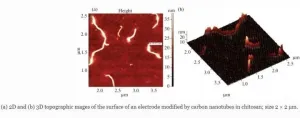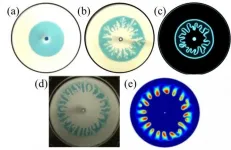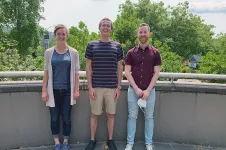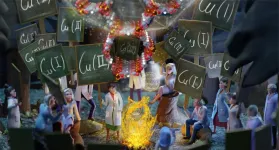Amperometric biosensors used to control diclofenac content in food
The study appeared in Journal of Analytical Chemistry
2021-07-06
(Press-News.org) The paper describes amperometric biosensors developed for the determination of diclofenac based on planar platinum electrodes modified with carbon nanotubes (CNTs) in chitosan, fullerene C60 in Boltorn H20, gold nanoparticles (Au NPs) in chitosan, and immobilized tyrosinase enzyme. It was found that diclofenac is a reversible tyrosinase inhibitor (a decrease in the analytical signal is observed), which makes it possible to determine it using appropriate biosensors modified with nanomaterials in the concentration range from 10 pM to 1 μM with CH 5 pM. Modification with composites of CNT / Au NPs and fullerene C60 / Au NPs made it possible to improve the analytical characteristics of the developed biosensors, in particular, to expand the range of determined concentrations and reduce CH compared to the unmodified analogue.
Kinetic studies of the reaction of enzymatic conversion of phenol showed that noncompetitive inhibition is observed in the presence of diclofenac on a tyrosinase biosensor.
The content of this drug in food is strictly regulated by European Union regulations, according to which the MPC for diclofenac in milk is 0.1 μg / l.
In this case, diclofenac was not detected in four studied milk samples with 1.5% fat content.
To assess the correctness of the results obtained for the determination of diclofenac using the developed biosensors, the method of fluorescence polarization was used.
The results show that the developed tyrosinase biosensor modified with CNT/Au NPs is not inferior in its analytical capabilities to known analogs, and in some cases even surpasses them and can be used for milk quality control.
Currently, non-steroidal anti-inflammatory drugs (NSAIDs) are often used as analgesics and anti-inflammatory treatment in diseases of the musculoskeletal system. Drugs of this class have a wide range of side effects, which, according to statistics, manifest in 10% of patients. NSAIDs are used in veterinary medicine to treat cattle and, therefore, can be found in dairy products. With that in mind, the content of NSAIDs in food should be strictly controlled. Diclofenac is one of the widely used medications of this class.
Since the presence of diclofenac in baby food is unacceptable, and its content in food products is subject to strict control, the determination of the content of this drug in food products, such as dairy, meat, and processed products, is very important. Recently, information about the content of diclofenac in seawater and wastewater has become increasingly common, so monitoring the content of the drug in them is also an important task. Further improvement of biosensor devices with the involvement of modern ideas about the role of the surface in the mechanism of analytical response will be very useful both for solving specific problems and for the development of the theory of biosensorics in general.
INFORMATION:
[Attachments] See images for this press release:

ELSE PRESS RELEASES FROM THIS DATE:
2021-07-06
A new study by researchers at the University of Eastern Finland shows for the first time that blood-based measurement of glial fibrillary acidic protein (GFAP) enables distinguishing patients with frontotemporal dementia from those with primary psychiatric disorders or healthy individuals.
Frontotemporal dementia is the second most common cause of dementia in the working age population. Its diagnostics are complicated by the similar symptoms presented by patients with psychiatric disorders or other neurodegenerative diseases as well as the lack of reliable diagnostic tools for differentiating these patients from each other.
A new study by researchers at the University of Eastern Finland ...
2021-07-06
The international collaborative team of Tokyo University of Agriculture and Technology (TUAT) in Japan and Indian Institute of Technology Ropar (IIT Ropar) in India has explored, for the first time, viscous fingering (VF, one of classical interfacial hydrodynamics) of annular ring where VF in fluid of finite volume grow radially through combination of experiment and numerical simulation. They demonstrate that the VF of an annular ring is a persistent phenomenon in contrast to the transient nature of VF of a slice where VF in fluid of finite volume grow rectilinearly.
The researchers published their results ...
2021-07-06
New research evaluating the drugs commonly used by rheumatoid arthritis patients suggests two combinations could reduce the risk of heart attack and strokes.
The new publication in Frontiers in Cardiovascular Medicine has found that anti-rheumatic drug regimens that include either tumour necrosis factor inhibitors or hydroxychloroquine might significantly protect the endothelium in rheumatoid arthritis.
Occurring in about one in 100 people, rheumatoid arthritis (RA) is a common autoimmune disease which leads to inflammation and pain in the connective tissue of a patient's joints.
"Rheumatoid arthritis patients have an increased ...
2021-07-06
A research collaboration based in Kumamoto University (Japan) has shown that lysine-specific demethylase 1 (LSD1), an enzyme involved in gene expression, produces individualized metabolism depending on the type of acute myeloid leukemia cells. Cancer cells are known to have a unique ability to metabolize substances differently from normal cells, and this ability is considered to be a promising therapeutic target. The new research findings may contribute to the safe and effective use of LSD1 inhibitors as potential anticancer agents, and to the development of highly specific treatments for various ...
2021-07-06
Researchers have devised a way to multiply by more than ten-fold the accessible details of gene activity in individual cells. It's a big leap in the effort to understand cancer development, brain function, immunity and other biological processes driven by the complex interactions of multitudes of different cell types.
Organs and tissues are made up of cells that may look the same, but individual cells can actually differ dramatically. Single-cell analysis allows the study of this cell-to-cell variation within an organ, tissue or cancerous tumor. But the research has been hampered by limits on the depth of information that can be gleaned at the single-cell level when working with large numbers of cells.
"The downside has been the low-quality of ...
2021-07-06
Most of us are familiar with the fact that women live longer than men. But fellas, if we told you there was one thing that could be done to increase your lifespan, would you do it?
In a study published today in eLife , University of Otago researchers along with collaborators from the United States, have shown that castration of male sheep delays aging of DNA compared to intact males, and that it also drives feminine characteristics of DNA and the chemical tags it holds, known as DNA methylation.
"Both farmers and scientists have known for some time that castrated male sheep live on average much longer than their intact counterparts; however, this is ...
2021-07-06
Three mutations in the Epsilon coronavirus spike protein dampen the neutralizing potency of antibodies induced by current vaccines or past COVID infections.
The mutations give this coronavirus variant of concern a means to totally evade specific monoclonal antibodies used in clinics and reduce the effectiveness of antibodies from the plasma of vaccinated people.
To better understand the exact immune escape strategies at work here, the scientists visualized this variant's infection machinery to see what is different from the original configuration of the pandemic coronavirus, and what the implications of these changes are.
The international project was led by David Veesler's lab in the Department of Biochemistry at the University of Washington ...
2021-07-06
In a retrospective, multi-centre cohort study conducted by researchers from Nanjing University, Huazhong University of Science and Technology, Jinling Hospital and the Second Hospital of Nanjing, a microRNA-like small RNA encoded by SARS-CoV-2 was identified in the serum of COVID-19 patients, which can be developed as a non-invasive biomarker for stratification of severe patients from mild/moderate ones and for identification of high-risk individuals before clinical manifestation of severe symptoms. This biomarker ensures proper allocation of patients to different ...
2021-07-06
A research team, led by Professor Dai-Sik Kim in the Department of Physics at UNIST has developed a new technique of predefining the crack pattern on a flexible substrate by a sequential deposition of metallic layers which leads to a formation of a "zero-nanometer gap, or a "zerogap," between the adjacent lateral patterns.
These gaps, according to the research team, readily open and recover with gentle bending and relaxing of the flexible substrate, precisely along the rims of the pre-patterns of centimeter lengths. Furthermore, in a prototypical pattern of densely packed slit arrays, these gaps serve as antennas achieving transparency for polarizations perpendicular to the length of the gap when opened ...
2021-07-06
Chemical elements make up pretty much everything in the physical world. As of 2016, we know of 118 elements, all of which can be found categorized in the famous periodic table that hangs in every chemistry lab and classroom.
Each element in the periodic table appears as a one-, two-letter abbreviation (e.g. O for oxygen, Al for aluminum) along with its atomic number, which shows how many protons there are in the element's nucleus. The number of protons is enormously important, as it also determines how many electrons orbit the nucleus, which essentially makes the element what it is and gives it its chemical properties. In short, the atomic number is an element's ID card.
The periodic table ...
LAST 30 PRESS RELEASES:
[Press-News.org] Amperometric biosensors used to control diclofenac content in food
The study appeared in Journal of Analytical Chemistry





